NCERT Solutions Class 6 MathsChapter - 3: Playing with NumbersExercise 3.11. Write all the factors of the following numbers : (a) 24 Answer: 1, 2, 3, 4, 6, 8, 12, 24 1 × 24 = 24 2 × 12 = 24 3 × 8 = 24 6 × 4 = 24 Or 24 × 1 = 24 12 × 2 = 24 8 × 3 = 24 4 × 6 = 24 (b) 15 Answer: 1, 3, 5, 15 1 × 15 = 15 3 × 5 = 15 Or 15 × 1 = 15 5 × 3 = 15 (c) 21 Answer: 1, 3, 7, 21 1 × 21 = 21 3 × 7 = 21 Or 21 × 1 = 21 7 × 3 = 21 (d) 27 Answer: 1, 3, 9, 27 1 × 27 = 27 3 × 9 = 27 Or 27 × 1 = 27 9 × 3 = 27 (e) 12 Answer: 1, 2, 3, 4, 6, 12 1 × 12 = 12 2 × 6 = 12 3 × 4 = 12 Or 12 × 1 = 12 6 × 2 = 12 4 × 3 = 12 (f) 20 Answer: 1, 2, 4, 5, 10, 20 1 × 20 = 20 2 × 10 = 20 5 × 4 = 20 Or 20 × 1 = 20 10 × 2 = 20 4 × 5 = 20 (g) 18 Answer: 1, 2, 3, 6, 9, 18 1 × 18 = 18 2 × 9 = 18 3 × 6 = 18 Or 18 × 1 = 18 9 × 2 = 18 6 × 3 = 18 (h) 23 Answer: 1, 23 1 × 23 = 23 Or 23 × 1 = 23 (i) 36 Answer: 1, 2, 3, 4, 9, 12, 18, 36 1 × 36 = 36 2 × 18 = 36 4 × 9 = 36 3 × 12 = 36 Or 36 × 1 = 36 18 × 2 = 36 9 × 4 = 36 12 × 3 = 36 2. Write first five multiples of : (a) 5 Answer: 5, 10, 15, 20, 25 5 × 1 = 5 5 × 2 = 10 5 × 3 = 15 5 × 4 = 20 5 × 5 = 25 (b) 8 Answer: 8, 16, 24, 32, 40 8 × 1 = 8 8 × 2 = 16 8 × 3 = 24 8 × 4 = 32 8 × 5 = 40 (c) 9 Answer: 9, 18, 27, 36, 45 9 × 1 = 9 9 × 2 = 18 9 × 3 = 27 9 × 4 = 36 9 × 5 = 45 3. Match the items in column 1 with the items in column 2.
4. Find all the multiples of 9 upto 100. Answer: 9, 18, 27, 26, 45, 54, 63, 72, 81, 90, 99 9 × 1 = 9 9 × 2 = 18 9 × 3 = 27 9 × 4 = 36 9 × 5 = 45 9 × 6 = 54 9 × 7 = 63 9 × 8 = 72 9 × 9 = 81 9 × 10 = 90 9 × 11 = 99 Exercise 3.21. What is the sum of any two (a) Odd numbers? Answer: The sum of any two odd numbers is always an even number. For example, 3 + 3 = 6 5 + 7 = 12 7 + 9 = 16 (b) Even numbers? Answer: The sum of any two even numbers is always an even number. For example, 4 + 6 = 10 2 + 6 = 8 10 + 14 = 24 2. State whether the following statements are True or False: (a) The sum of three odd numbers is even. Answer: False Explanation: The sum of three odd numbers is an odd number. For example, 3 + 3 + 3 = 9 1 + 1 + 1 = 3 (b) The sum of two odd numbers and one even number is even. Answer: True Explanation: The sum of two odd numbers is always an even number. An even number added to an even number is also an even number. For example, 3 (odd) + 5 (odd) + 2 (even) = 10 (even) 1 (odd) + 7 (odd) + 4 (even) = 12 (even) (c) The product of three odd numbers is odd. Answer: True Explanation: The product of three odd numbers is an odd number. For example, 3 × 1 × 3 = 9 5 × 1 × 3 = 15 (d) If an even number is divided by 2, the quotient is always odd. Answer: False Explanation: If an even number is divided by 2, the quotient can be an even number or an odd number. It is not always odd. Instead, it can be either odd or even. For example, 10/2 = 5 (odd) 20/2 = 10 (even) (e) All prime numbers are odd. Answer: False Explanation: 2 is an prime number, which is even. (f) Prime numbers do not have any factors. Answer: False Explanation: Prime numbers have two factors, 1 and the number itself. For example, The factors of prime number 7 are 1 and 7. (g) Sum of two prime numbers is always even. Answer: False Explanation: Sum of two prime number is not always even. It can be odd as well. For example, 2 (prime) + 3 (prime) = 5 (odd) (h) 2 is the only even prime number. Answer: True Explanation: 2 is the only even prime number. (i) All even numbers are composite numbers. Answer: False Explanation: A number that has more than two factors is called a composite number. All even numbers are not composite numbers because even number 2 is also a prime number. (j) The product of two even numbers is always even. Answer: True Explanation: The product of two even numbers is always an even number. For example, 4 × 6 = 24 (even) 10 × 4 = 40 (even) 3. The numbers 13 and 31 are prime numbers. Both these numbers have same digits 1 and 3. Find such pairs of prime numbers upto 100. Answer: 17 and 71, 37 and 73, 79 and 97 Thus, there ar three such pairs of prime numbers upto 100. 1. 17 and 71 2. 37 and 73 3. 79 and 97 4. Write down separately the prime and composite numbers less than 20. Answer: 2, 3, 5, 7, 11, 13, 17, and 19 The prime and composite numbers less than 20 are 2, 3, 5, 7, 11, 13, 17, and 19. 5. What is the greatest prime number between 1 and 10? Answer: 7 7 is the greatest prime number between 1 and 10. 6. Express the following as the sum of two odd primes. (a) 44 Answer: 37 + 7 or 41 + 3 or 31 + 13 (b) 36 Answer: 31 + 5 or 29 + 7 or 23 + 13 or 17 + 19 (c) 24 Answer: 19 + 5 or 17 + 7 or 13 + 11 (d) 18 Answer: 11 + 7 or 5 + 13 7. Give three pairs of prime numbers whose difference is 2. [Remark : Two prime numbers whose difference is 2 are called twin primes]. Answer: 3 and 5, 11 and 13, 17 and 19 We can give any three pairs of prime numbers whose difference is 2. Other pairs include 5 and 7, 29 and 31 8. Which of the following numbers are prime? (a) 23 Answer: It is a prime number. (b) 51 Answer: It is not a prime number. The factors of 51 are 1, 3, 17, and 51. (c) 37 Answer: It is a prime number. (d) 26 Answer: : It is not a prime number. The factors of 26 are 1, 2, 13, and 26. 9. Write seven consecutive composite numbers less than 100 so that there is no prime number between them. Answer: 90, 91, 92, 93, 94, 95, 96 The seven consecutive composite numbers less than 100 with no prime number between them are 90, 91, 92, 93, 94, 95, and 96. Consecutive numbers are the numbers that follow each other continuously in the order of small to large. 10. Express each of the following numbers as the sum of three odd primes: (a) 21 Answer: 3, 5, 13 21 = 3 + 5 + 13 Where, 3, 5, and 13 are the odd prime numbers (b) 31 Answer: 3, 5, 23 31 = 3 + 5 + 23 Where, 3, 5, and 13 are the odd prime numbers (c) 53 Answer: 3, 7, 43 3 + 7 + 43 = 53 Where 3, 7, and 43 are the odd prime numbers Or 13, 17, 23 13 + 17 + 23 = 43 Where, 13, 17, and 23 are the odd prime numbers. (d) 61 Answer: 13, 7, 41 13 + 7 + 41 = 61 Where, 13, 7, and 41 are the odd prime numbers. 11. Write five pairs of prime numbers less than 20 whose sum is divisible by 5. (Hint : 3+ 7 = 10) Answer: The five pairs of prime numbers less than 20 are: 1. 2 + 3 = 5 2. 13 + 2 = 15 3. 17 + 3 = 20 4. 3 + 7 = 10 5. 13 + 17 = 30 Other pair is: 6. 11 + 19 = 30 12. Fill in the blanks: (a) A number which has only two factors is called a prime number. (b) A number which has more than two factors is called a composite number. (c) 1 is neither prime number nor composite number. (d) The smallest prime number is 2. (e) The smallest composite number is 4. (f) The smallest even number is 2. Exercise 3.31. Using divisibility tests, determine which of the following numbers are divisible by 2; by 3; by 4; by 5; by 6; by 8; by 9; by 10 ; by 11 (say, yes or no): 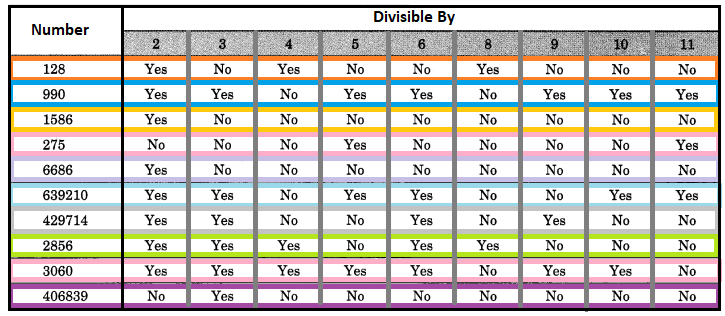
2. Using divisibility tests, determine which of the following numbers are divisible by 4; by 8: If the last two digits of a number are divisible by 4e number is said to be divisible by 4. If the last three digits of a number are divisible by 8,the number is said to be divisible by 8. (a) 572 Answer: 572 is divisible by 4, but not by 8. Explanation: The last two digits of 572, i.e., 72 is divisible by 4. Hence, the number is also divisible by 4. The last three digits of 572, i.e., 572 is not divisible by 8. Hence, the number is also not divisible by 8. (b) 726352 Answer: 726352 is divisible by 4 and 8. Explanation: The last two digits of 726352, i.e., 52 is divisible by 4. Hence, the number is also divisible by 4. The last three digits of 726352, i.e., 352 is divisible by 8. Hence, the number is also divisible by 8. (c) 5500 Answer: 5500 is divisible by 4, but not by 8. Explanation: The last two digits of 5500, i.e., 00 is divisible by 4. Hence, the number is also divisible by 4. The last three digits of 5500, i.e., 500 is not divisible by 8. Hence, the number is also not divisible by 8. (d) 6000 Answer: 6000 is divisible by 4 and 8. Explanation: The last two digits of 6000, i.e., 00 is divisible by 4. Hence, the number is also divisible by 4. The last three digits of 6000, i.e., 000 is divisible by 8. Hence, the number is also divisible by 8. (e) 12159 Answer: 12159 is not divisible by 4 and 8. Explanation: The last two digits of 12159, i.e., 59 is not divisible by 4. Hence, the number is also not divisible by 4. The last three digits of 12159, i.e., 159 is not divisible by 8. Hence, the number is also not divisible by 8. (f) 14560 Answer: 14560 is divisible by 4 and 8. Explanation: The last two digits of 14560, i.e., 60 is divisible by 4. Hence, the number is also divisible by 4. The last three digits of 14560, i.e., 560 is divisible by 8. Hence, the number is also divisible by 8. (g) 21084 Answer: 21084 is divisible by 4, but not by 8. Explanation: The last two digits of 21084, i.e., 84 is divisible by 4. Hence, the number is also divisible by 4. The last three digits of 21084, i.e., 084 is not divisible by 8. Hence, the number is also not divisible by 8. (h) 31795072 Answer: 31795072 is divisible by 4 and 8. Explanation: The last two digits of 31795072, i.e., 72 is divisible by 4. Hence, the number is also divisible by 4. The last three digits of 31795072, i.e., 072 is divisible by 8. Hence, the number is also divisible by 8. (i) 1700 Answer: 1700 is divisible by 4, but not by 8. Explanation: The last two digits of 1700, i.e., 00 is divisible by 4. Hence, the number is also divisible by 4. The last three digits of 1700, i.e., 700 is not divisible by 8. Hence, the number is also not divisible by 8. (j) 2150 Answer: 2150 is not divisible by 4 and 8. Explanation: The last two digits of 2150, i.e., 50 is not divisible by 4. Hence, the number is also not divisible by 4. The last three digits of 2150, i.e., 150 is not divisible by 8. Hence, the number is also not divisible by 8. Thus, (a), (b), (c), (d), (f), (g), (h), and (i) are divisible by 4. (b), (d), (h), and (f) are divisible by 8. 3. Using divisibility tests, determine which of following numbers are divisible by 6: If a number is divisible by both 2 and 3, it is also divisible by 6. A number with 0, 2, 4, 6, and 8 at the unit's place is divisible by 2. If the sum of digits is a multiple of 3, the number is divisible by 3. (a) 297144 Answer: It is divisible by 6. Dvisible by 2: 297144 has number 4 at the unit place. Hence, it is divisible by 2. Divisible by 3: 2 + 9 + 7 + 1 + 4 + 4 = 27 27 is a multiple of 3. 9 × 3 = 27 Hence, it is divisible by 3. 297144 is divisible by both 2 and 3. Thus, it is also divisible by 6. (b) 1258 Answer: It is not divisible by 6. Dvisible by 2: 1258 has number 8 at the unit place. Hence, it is divisible by 2. Divisible by 3: 1 + 2 + 5 + 8 = 16 16 is not a multiple of 3. Hence, it is not divisible by 3. 1258 is divisible by 2 but not by 3. Thus, it is not divisible by 6. (c) 4335 Answer: It is not divisible by 6. Dvisible by 2: 4335 has number 5 at the unit place. Hence, it is not divisible by 2. Divisible by 3: 4 + 3 + 3 + 5 = 15 15 is a multiple of 3. 3 x 5 = 15 Hence, it is divisible by 3. 1258 is divisible by 3 but not by 2. Thus, it is not divisible by 6. (d) 61233 Answer: It is not divisible by 6. Dvisible by 2: 61233 has number 3 at the unit place. Hence, it is not divisible by 2. Divisible by 3: 6 + 1 + 2 + 3 + 3 = 15 15 is a multiple of 3. 3 x 5 = 15 Hence, it is divisible by 3. 61233 is divisible by 3 but not by 2. Thus, it is not divisible by 6. (e) 901352 Answer: It is not divisible by 6. Dvisible by 2: 901352 has number 2 at the unit place. Hence, it is divisible by 2. Divisible by 3: 9 + 0 + 1 + 3 + 5 + 2 = 20 20 is not a multiple of 3. Hence, it is not divisible by 3. 901352 is divisible by 2 but not by 3. Thus, it is not divisible by 6. (f) 438750 Answer: It is divisible by 6. Dvisible by 2: 438750 has number 0 at the unit place. Hence, it is divisible by 2. Divisible by 3: 4 + 3 + 8 + 7 + 5 + 0 = 27 27 is a multiple of 3. 9 × 3 = 27 Hence, it is divisible by 3. 438750 is divisible by both 2 and 3. Thus, it is also divisible by 6. (g) 1790184 Answer: It is divisible by 6. Dvisible by 2: 1790184 has number 4 at the unit place. Hence, it is divisible by 2. Divisible by 3: 1 + 7 + 9 + 0 + 1 + 8 + 4 = 30 30 is a multiple of 3. 10 × 3 = 30 Hence, it is divisible by 3. 1790184 is divisible by both 2 and 3. Thus, it is also divisible by 6. (h) 12583 Answer: It is not divisible by 6. Dvisible by 2: 12583 has number 3 at the unit place. Hence, it is not divisible by 2. Divisible by 3: 1 + 2 + 5 + 8 + 3 = 19 19 is not a multiple of 3. Hence, it is not divisible by 3. 12583 is neither divisible by 2 nor 3. Thus, it is not divisible by 6. (i) 639210 Answer: It is divisible by 6. Dvisible by 2: 639210 has number 0 at the unit place. Hence, it is divisible by 2. Divisible by 3: 6 + 3 + 9 + 2 + 1 + 0 = 21 21 is a multiple of 3. 7 × 3 = 21 Hence, it is divisible by 3. 639210 is divisible by both 2 and 3. Thus, it is also divisible by 6. (j) 17852 Answer: It is not divisible by 6. Dvisible by 2: 17852 has number 2 at the unit place. Hence, it is divisible by 2. Divisible by 3: 1 + 7 + 8 + 5 + 2 = 23 23 is not a multiple of 3. Hence, it is not divisible by 3. 17852 is divisible by 2 but not by 3. Thus, it is not divisible by 6. 4. Using divisibility tests, determine which of the following numbers are divisible by 11: A number is divisible by 11 if the difference between the sum of the digits at odd places (from the right) and the sum of the digits at even places (from the right) of the number is either 0 or divisible by 11. (a) 5445 Answer: It is divisible by 11. Sum of digits at odd places: 5 + 4 = 9 Sum of digit at even places: 4 + 5 = 9 Difference: 9 - 9 = 0 Hence, 5445 is divisible by 11. (b) 10824 Answer: It is divisible by 11. Sum of digits at odd places: 4 + 8 + 1 = 13 Sum of digit at even places: 2 + 0 = 2 Difference: 13 - 2 = 11 11 is divisible by 11. 11 × 1 = 11 Hence, 10824 is divisible by 11. (c) 7138965 Answer: It is not divisible by 11. Sum of digits at odd places: 5 + 9 + 3 + 7 = 24 Sum of digit at even places: 6 + 8 + 1 = 15 Difference: 24 - 15 = 9 9 is not divisible by 11. Hence, 7138965 is not divisible by 11. (d) 70169308 Answer: It is divisible by 11. Sum of digits at odd places: 8 + 3 + 6 + 0 = 17 Sum of digit at even places: 0 + 9 + 1 + 7 = 17 Difference: 17 - 17 = 0 Hence, 70169308 is divisible by 11. (e) 10000001 Answer: It is divisible by 11. Sum of digits at odd places: 1 + 0 + 0 + 0 = 1 Sum of digit at even places: 0 + 0 + 0 + 1 = 1 Difference: 1 - 1 = 0 Hence, 10000001 is divisible by 11. (f) 901153 Answer: It is divisible by 11. Sum of digits at odd places: 3 + 1 + 0 = 4 Sum of digit at even places: 5 + 1 + 9 = 15 Difference: 15 - 4 = 11 11 is divisible by 11. 11 × 1 = 11 Hence, 901153 is divisible by 11. 5. Write the smallest digit and the greatest digit in the blank space of each of the following numbers so that the number formed is divisible by 3: If the sum of digits is a multiple of 3, the number is divisible by 3. (a) __ 6724 Answer: 2 and 8 Explanation: Let's consider the blank space be a. a + 6 + 7 + 2 + 4 = a + 19 Smallest: In case of smallest, we need to consider the nearest number. The nearest number to 19, which is divisible by 3 is 21. a + 19 = 21 a = 21 - 19 a = 2 Thus, 2 is the smallest digit that makes the number divisible by 3. Greatest: The farthest number to 19, which is divisible by 3 is 27. If we will consider 30, the gap will be more than 10. We need to consider the gap between the numbers to be less than 9. a + 19 = 27 a = 27 - 19 a = 8 Thus, 8 is the greatest digit that makes the number divisible by 3. (b) 4765 __ 2 Answer: 0 ad 9 Explanation: Let's consider the blank space be a. 4 + 7 + 6 + 5 + a + 2 = a + 24 Smallest: In case of smallest, we need to consider the nearest number. The nearest number to 24 is 24 only. It is because 24 is also divisible by 3. a + 24 = 24 a = 24 - 24 a = 0 Thus, 0 is the smallest digit that makes the number divisible by 3. Greatest: The farthest number to 24, which is divisible by 3 is 33. If we will consider 36, the gap will be more than 10. We need to consider the gap between the numbers to be less or equal to 9. a + 24 = 33 a = 33 - 24 a = 9 Thus, 9 is the greatest digit that makes the number divisible by 3. 6. Write a digit in the blank space of each of the following numbers so that the number formed is divisible by 11 : A number is divisible by 11 if the difference between the sum of the digits at odd places (from the right) and the sum of the digits at even places (from the right) of the number is either 0 or divisible by 11. (a) 92 __ 389 Answer: 8 Let the blank space digit be a. Sum of digits at odd places: 9 + 3 + 2 = 14 Sum of digits at even places: 8 + a + 9 = 17 + a Difference = (17 + a) - 14 = 3 + a The nearest number to 3 that is divisible by 11 is 11. 3 + a = 11 a = 8 We cannot take 0 because the digit may become negative. 3 + a = 0, a = -3 It is not a required digit. We only require positive digits. (b) 8 __ 9484 Answer: 6 Let the blank space digit be a. Sum of digits at odd places: 4 + 4 + a = 8 + a Sum of digits at even places: 8 + 9 + 8 = 25 Difference = 25 - (8 + a) = 25 - 8 - a = 17 - a The nearest number that is divisible by 11 is 11. 17 - a = 11 a = 17 - 11 a = 6 We cannot take 22 because the number (a) is in negative. By taking 22, we may get a negative number. 17 - a = 22 a = -5 It is not a required digit. We only require positive digits. If we take 0, we may get a two digit number. We only require a single digit number in the blank space. 17 - a = 0, a = 17 It is also not required. Exercise 3.41. Find the common factors of : (a) 20 and 28 Answer: 1, 2, 4 Factors of 20: 1, 2, 4, 5, 10, 20 Factors of 28: 1, 2, 4, 7, 14, 28 These two number has 1, 2, and 4 in common. (b) 15 and 25 Answer: 1, 5 Factors of 15: 1, 3, 5, 15 Factors of 25: 1, 5, 25 These two numbers has 1 and 5 in common. (c) 35 and 50 Answer: 1, 5 Factors of 35: 1, 5, 7, 35 Factors of 50: 1, 2, 5, 10, 25, 50 These two numbers has 1 and 5 in common. (d) 56 and 120 Answer: 1, 2, 4, 8 Factors of 56: 1, 2, 4, 7, 8, 14, 28, 56 Factors of 120: 1, 2, 3, 4, 5, 6, 8, 10, 12, 15, 20, 30, 40, 60, 120 These two numbers has 1, 2, 4, and 8 in common. 2. Find the common factors of : (a) 4, 8 and 12 Answer: 1, 2, 4 Factors of 4: 1, 2, 4 Factors of 8: 1, 2, 4, 8 Factors of 12: 1, 2, 3, 4, 6, 12 These three numbers has 1, 2, and 4 in common. (b) 5, 15 and 25 Answer: 1, 5 Factors of 5: 1, 5 Factors of 15: 1, 3, 5 Factors of 25: 1, 5, 25 These three numbers has 1 and 5 in common. 3. Find first three common multiples of: (a) 6 and 8 Answer: 24, 48, 72 Common multiple refers to the numbers that are divisible by both 6 and 8. Multiples of 6: 6, 12, 18, 24, 30, 36, 42, 48, 54, 60, 66, 72, 78, 84, 90 Multiples of 8: 8, 16, 24, 32, 40, 48, 56, 64, 72, 80 Thus, the first three common multiples are 24, 48, and 72. (b) 12 and 18 Answer: 36, 72, 108 Common multiple refers to the numbers that are divisible by both 12 and 18. Multiples of 12: 12, 24, 36, 48, 60, 72, 84, 96, 108, 120 Multiples of 18: 18, 36, 54, 72, 90, 108, 126, 144, 162, 180 Thus, the first three common multiples are 36, 72, and 108. 4. Write all the numbers less than 100 which are common multiples of 3 and 4. Answer: 12, 24, 36, 48, 60, 72, 84, 96. Multiples of 3: 3, 6, 9, 12, 15, 18, 21, 24, 27, 30, 33, 36, 39, 42, 45, 48, 51, 54, 57, 60, 63, 66, 69, 72, 75, 78, 81, 84, 87, 90, 93, 96, 99 Multiples of 4: 4, 8, 12, 16, 20, 24, 28, 32, 36, 40, 44, 48, 52, 56, 60, 64, 68, 72, 76, 80, 84, 88, 92, 96 Thus, the common multiples of 3 and 4 less than 100 are 12, 24, 36, 48, 60, 72, 84, and 96. 5. Which of the following numbers are co-prime? Two numbers having only 1 as a common factor are called co-prime numbers. (a) 18 and 35 Answer: It is a co-prime number. 18 and 35 have only 1 as a common factor. Factors of 18: 1, 2, 3, 6, 9, 18 Factors of 35: 1, 5, 7, 35 (b) 15 and 37 Answer: It is a co-prime number. 15 and 37 have only 1 as a common factor. Factors of 15: 1, 3, 5, 15 Factors of 37: 1, 37 (c) 30 and 415 Answer: It is not a co-prime number. Factors of 30: 1, 2, 3, 5, 6, 10, 15, 30 Factors of 415: 1, 5, 83, 415 30 and 415 have factors 1 and 5 in common. Hence, it is not a co-prime number. (d) 17 and 68 Answer: It is not a co-prime number. Factors of 17: 1, 17 Factors of 68: 1, 2, 4, 17, 34, 68 17 and 68 have factors 1 and 17 in common. Hence, it is not a co-prime number. (e) 216 and 215 Answer: It is a co-prime number. Factors of 216: 1, 2, 3, 4, 6, 8, 9, 12, 18, 24, 27, 36, 54, 72, 108, 216. Factors of 215: 1, 5, 45, 215 (f) 81 and 16 Answer: It is a co-prime number. Factors of 81: 1, 3, 9, 27, 81 Factors of 16: 1, 2, 4, 8, 16 6. A number is divisible by both 5 and 12. By which other number will that number be always divisible? Answer: 60 12 and 5 are co-prime numbers because it has only 1 as a common factor. Thus, if a number is divisible by both 5 and 12, it will be always divisible by its product, i.e. 12 × 5 = 60. 7. A number is divisible by 12. By what other numbers will that number be divisible? Answer: 1, 2, 3, 4, 6, 12 If a number is divisible by 12, it is also divisible by its factors. Factors of 12: 1, 2, 3, 4, 6, and 12 Exercise 3.51. Which of the following statements are true? (a) If a number is divisible by 3, it must be divisible by 9. Answer: False Explanation: If a number is divisible by 3, it is not always be divisible by 9. For example, Numbers: 6, 12, 15, 21, 24 These numbers are divisible by 3, but not by 9. (b) If a number is divisible by 9, it must be divisible by 3. Answer: True Explanation: If a number is divisible by 9, it is always divisible by 3. For example, Numbers: 9, 18, 27, 36, 45 These numbers are divisible by 9. Hence, also divisible by 3. (c) A number is divisible by 18, if it is divisible by both 3 and 6. Answer: False Explanation: A number is not always divisible by 18, if it is divisible by both 3 and 6. For example, Numbers: 12, 24, 30, 42 The above numbers are divisible by both 3 and 6, but not by 18. In some cases, it might be true. For example, Numbers: 18, 36, 54, 72 These numbers are divisible by 3, 6, as well as 18. (d) If a number is divisible by 9 and 10 both, then it must be divisible by 90. Answer: True Explanation: Number 9 ans 10 are co-prime numbers. Thus, if a number is divisible by both 9 and 10, it must be divisible by its product, i.e. 9 × 10 = 90. For example, 90, 180, 270, 360 (e) If two numbers are co-primes, at least one of them must be prime. Answer: False Expnlanation: The numbers that has only has 1 as a common factor are the c-prime numbers. Any type of numbers can be co-prime if their common factor is 1. For example, 9 and 20 Factors of 9: 1, 3, 9 Factors of 20: 1, 2, 5, 10, 20 Both have only 1 as a common factor and neither of them is a prime number. (f) All numbers which are divisible by 4 must also be divisible by 8. Write the prime factorisations of 16, 28, 38. Answer: False Explanation: If a number is divisible by 4, it is not always divisible by 8. For example, Numbers: 12, 16, 20, 24, 28, 32, 36 All these numbers are divisible by 4. But among these, only 16, 24, and 32 are divisible by 8. (g) All numbers which are divisible by 8 must also be divisible by 4. Answer: True Explanation: If a number is divisible by 8, it is also divisible by 4. Factors of 8: 1, 2, 4, and 8 Thus, if a number is divisible by 8, it is always divible by its factors. For example, Numbers: 8, 16, 24, 32, 40, 48, 56 These numbers are divisible both by 4 and 8. (h) If a number exactly divides two numbers separately, it must exactly divide their sum. Answer: True Explanation: If a number exactly divides two numbers separately, it must exactly divide their sum. For example, Number: 4 4 divides 8 and 16. Sum: 8 + 16 = 24 Thus, number 4 exactly divides 8 and 16 separately, and also divides their sum (8 + 16 = 24). (i) If a number exactly divides the sum of two numbers, it must exactly divide the two numbers separately. Answer: False Explanation: A number cannot divide the two numbers separately, if it divides their sum. For example, Number: 6 6 divides 24. But, it does not divide their sum (10 + 14). It is possible only in some cases. For example, 6 divides 24 and also divide the numbers separately (18 + 6). Thus, the above condition is true only in some cases. 2. Here are two different factor trees for 60. Write the missing numbers. (a) 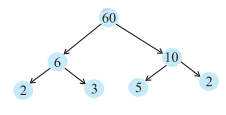
2 × 3 = 6 5 × 2 = 10 (b) 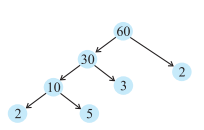
30 × 2 = 60 10 × 3 = 30 2 × 5 = 10 3. Which factors are not included in the prime factorisation of a composite number? Answer: The commo factors of every number is 1 and the number itself. Thus, factors 1 and the number itself are not included in the prime factorisation of a composite number. 4. Write the greatest 4-digit number and express it in terms of its prime factors. Answer: 9999 9999 is the greatest 4-digit number. Prime factors of 9999: 3, 3, 11, 101 101 × 11 × 3 × 3 = 9999 9999 = 9 × 1111 9999 = (3 × 3) × (101 × 11) 5. Write the smallest 5-digit number and express it in the form of its prime factors. Answer: 10000 10000 is the smallest 5-digit number. Prime factors of 10000: 2, 2, 2, 2, 5, 5, 5, 5 2 × 2 × 2 × 2 × 5 × 5 × 5 × 5 = 10000 10000 = 4 × 2500 10000 = (2 × 2) × (25 × 100) 10000 = (2 × 2) × (5 × 5 × 4 × 25) 10000 = (2 × 2) × (5 × 5 × 2 × 2 × 5 × 5) 10000 = 2 × 2 × 2 × 2 × 5 × 5 × 5 × 5 6. Find all the prime factors of 1729 and arrange them in ascending order. Now state the relation, if any; between two consecutive prime factors. Answer: 7, 13, 19 The prime factors of 1729 are 7, 13, and 19. 7 × 13 × 19 = 1729 There are three prime factors. The relation between them is: 13 - 7 = 6 19 - 13 = 6 Thus, the three consective prime factors in ascending order differs by 6. Note: Factors and prime factors are the different terms. Prime factors does not include factor 1 and the number itself.7. The product of three consecutive numbers is always divisible by 6. Verify this statement with the help of some examples. Answer: The three consecutive numbers always include a number divisible by 2 or 3. The product of such three numbers is divisible by both 2 and 3. Thus, if a number is divisible by both 2 and 3, it is also divisible by 6. Example 1: 1, 2, 3 1 × 2 × 3 = 6 Example 2: 3, 4, 5 3 × 4 × 5 = 60 Example 3: 6, 7, 8 6 × 7 × 8 = 336 Example 4: 8, 9, 10 8 × 9 × 10 = 720 8. The sum of two consecutive odd numbers is divisible by 4. Verify this statement with the help of some examples. Answer: The sum of odd numbers is always even. Similarly, the sum of two consecutive odd numbers is divisible by 4. For example, 1 and 3 1 + 3 = 4 4 is divisible by 4. 3 and 5 3 + 5 = 8 8 is divisible by 4. 5 and 7 5 + 7 = 12 12 is divisible by 4. 7 and 9 7 + 9 = 16 16 is divisible by 4. 9 and 11 9 + 11 = 20 20 is divisible by 4. 9. In which of the following expressions, prime factorisation has been done? Prime factors are the factors that divides the number repeatedly so long as the quotient is divisible by that number. (a) 24 = 2 × 3 × 4 Answer: It is not the proper prime factorization. It is because the factors of 4 are (2, 2). Correct: 24 = 2 × 3 × 2 × 2 (b) 56 = 7 × 2 × 2 × 2 Answer: It is the correct prime factorization. (c) 70 = 2 × 5 × 7 Answer: It is the correct prime factorization. (d) 54 = 2 × 3 × 9 Answer: It is not the proper prime factorization. It is because the factors of 9 are (3, 3). Correct: 24 = 2 × 3 × 3 × 3 10. Determine if 25110 is divisible by 45. [Hint : 5 and 9 are co-prime numbers. Test the divisibility of the number by 5 and 9]. Answer: 45 = 9 × 5 Since, 5 and 9 are the co-prime numbers. So, if a number is divisible by 5 and 9, it is also divisible by their product (9 × 5 = 45). Divisible by 9: If the sum of the digits of a number is divisible by 9, then the number itself is divisible by 9. 2 + 5 + 1 + 1 + 0 = 9 9 × 1 = 9 9 is divisible by 9. Hence, 25110 is divisible by 9. Divisible by 5: If the unit digit of a number is either 0 or 5, the number is divisible by 5. The unit digit of 25110 is 0. Hence, it is divisible by 5. 25110 is divisible by both 5 and 9. Hence, it is also divisible by their product (9 × 5 = 45). 11. 18 is divisible by both 2 and 3. It is also divisible by 2 × 3 = 6. Similarly, a number is divisible by both 4 and 6. Can we say that the number must also be divisible by 4 × 6 = 24? If not, give an example to justify your answer. Answer: No. If a number is divisible by both 4 and 6, it id not necessary that is also divisible by 24. For example, 12, 36, 60 The above numbers are divisible by both 4 and 6, but not by 24. 12. I am the smallest number, having four different prime factors. Can you find me? Answer: The four different prime factors of the smallest number must be smallest. Let the factors be 2, 3, 5, 7. Number: 2 × 3 × 5 × 7 Number: 210 We cannot taked 4 and 6 as the factors because it contains the repeated digits 2 and 3. Exercise 3.61. Find the HCF of the following numbers : The Highest Common Factor (HCF) of two or more given numbers is the highest (or greatest) of their common factors. (a) 18, 48 Answer: 6 Factors of 18: 2 × 3 × 3 Factors of 48: 2 × 2 × 2 × 2 × 3 Common factors of 18 and 48 are: 2 × 3 Thus, HCF = 6 (b) 30, 42 Answer: 6 Factors of 30: 2 × 3 × 5 Factors of 42: 2 × 3 × 7 Common factors of 30 and 42 are: 2 × 3 Thus, HCF = 6 (c) 18, 60 Answer: 6 Factors of 18: 2 × 3 × 3 Factors of 60: 2 × 3 × 2 × 5 Common factors of 18 and 60 are: 2 × 3 Thus, HCF = 6 (d) 27, 63 Answer: 9 Factors of 27: 3 × 3 × 3 Factors of 63: 3 × 3 × 7 Common factors of 27 and 63 are: 3 × 3 Thus, HCF = 9 (e) 36, 84 Answer: Factors of 36: 2 × 2 × 3 × 3 Factors of 84: 2 × 2 × 3 × 7 Common factors of 36 and 84 are: 2 × 2 × 3 Thus, HCF = 12 (f) 34, 102 Answer: 34 Factors of 34: 2 × 17 Factors of 102: 2 × 3 × 17 Common factors of 34 and 102 are: 2 × 17 Thus, HCF = 34 (g) 70, 105, 175 Answer: 35 Factors of 70: 2 × 7 × 5 Factors of 105: 7 × 5 × 3 Factors of 175: 7 × 5 × 5 Common factors of 70, 105, and 175 are: 7 × 5 Thus, HCF = 35 (h) 91, 112, 49 Answer: 7 Factors of 91: 7 × 13 Factors of 112: 2 × 2 × 2 × 2 × 7 Factors of 49: 7 × 7 Common factors of 91, 112, and 49 are: 7 Thus, HCF = 7 (i) 18, 54, 81 Answer: 9 Factors of 18: 2 × 3 × 3 Factors of 54: 2 × 3 × 3 × 3 Factors of 81: 3 × 3 × 3 × 3 Common factors of 18, 54, and 81 are: 3 × 3 Thus, HCF = 9 (j) 12, 45, 75 Answer: 3 Factors of 18: 2 × 2 × 3 Factors of 45: 5 × 3 × 3 Factors of 75: 5 × 5 × 3 Common factors of 12, 45, and 75 are: 3 Thus, HCF = 3 2. What is the HCF of two consecutive (a) numbers? Answer: 1 There is only one common factor between any two consecutive numbers, i.e. 1. Hence, HCF of two consecutive numbers is 1. For example, 1 and 2 3 and 4 5 and 6 6 and 7 (b) even numbers? Answer: 2 There is only one common factor between any two consecutive even numbers, i.e. 2. Hence, HCF of two consecutive even numbers is 2. For example, 2 and 4 4 and 6 6 and 8 8 and 10 (c) odd numbers? Answer: 1 There is only one common factor between any two consecutive odd numbers, i.e. 1. Hence, HCF of two consecutive odd numbers is 1. For example, 1 and 3 5 and 7 7 and 9 11 and 13 3. HCF of co-prime numbers 4 and 15 was found as follows by factorisation : 4 = 2 × 2 and 15 = 3 × 5 since there is no common prime factor, so HCF of 4 and 15 is 0. Is the answer correct? If not, what is the correct HCF? Solution: No The correct answer is: 1 HCF of any two numbers can never be 0. The common factor of any two co-prime numbers is 1. Hence, HCF of such numbers with no common prime factors is always 1. Exercise 3.71. Renu purchases two bags of fertiliser of weights 75 kg and 69 kg. Find the maximum value of weight which can measure the weight of the fertiliser exact number of times. Solution: Weight of two bags of fertilizer = 75 kg and 69 kg Maximum value of weight = HCF (75, 69) Factors of 75: 5 × 5 × 3 Factors of 69: 3 × 23 Common factors of 75 and 69 are: 3 Thus, HCF = 3 The maximum value of weight 75 kg and 69 kg which can measure the weight of the fertiliser exact number of times is 3 kg. 2. Three boys step off together from the same spot. Their steps measure 63 cm, 70 cm and 77 cm respectively. What is the minimum distance each should cover so that all can cover the distance in complete steps? Solution: The steps measure of the first boy = 63 cm The steps measure of the second boy = 70 cm The steps measure of the third boy = 77 cm Minimum distance = LCM (63, 70, 77) 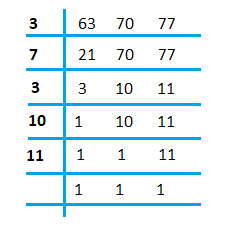
LCM = 3 × 7 × 3 × 10 × 11 LCM = 6930 Thus, the minimum distance of 6930 cm each should cover so that all can cover the distance in complete steps. 3. The length, breadth and height of a room are 825 cm, 675 cm and 450 cm respectively. Find the longest tape which can measure the three dimensions of the room exactly. Solution: The length of a room = 825 cm The breadth of a room = 675 cm The height of a room = 450 cm Longest tape = HCF (825, 675, 450) Factors of 825: 5 × 5 × 3 × 11 Factors of 675: 5 × 5 × 3 × 3 × 3 Factors of 450: 5 × 5 × 3 × 3 × 2 Common factors of 825, 675, 450 are: 5 × 5 × 3 Thus, HCF = 75 The longest tape which can measure the three dimensions of the room exactly is of length 75 cm. 4. Determine the smallest 3-digit number which is exactly divisible by 6, 8 and 12. Solution: To find the smallest 3-digit number, we need to find the LCM. LCM (Lowest Common Factor) of 6, 8 and 12 is: 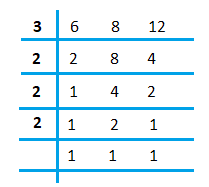
LCM = 3 × 2 × 2 × 2 LCM = 24 The smallest three digit number should be greater than 100. The nearest multiple of 24 greater than 100 is 24 × 5 = 120. Thus, the smallest 3-digit number which is exactly divisible by 6, 8 and 12 is 120. 5. Determine the greatest 3-digit number exactly divisible by 8, 10 and 12. Solution: The greatest 3-digit number is 999. LCM (8, 10, 12) 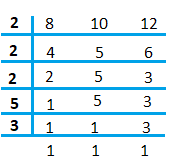
LCM = 2 × 2 × 2 × 5 × 3 = 120 The nearest 3-digit multiple of 120 near 999 is 120 × 8 = 960. Thus, the greatest 3-digit number exactly divisible by 8, 10 and 12 is 960. 6. The traffic lights at three different road crossings change after every 48 seconds, 72 seconds and 108 seconds respectively. If they change simultaneously at 7 a.m., at what time will they change simultaneously again? Solution: LCM (48, 72, 108) 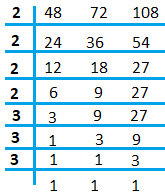
LCM = 2 × 2 × 2 × 2 × 3 × 3 × 3 = 432 = 60 × 7 + 12 = 7 minutes and 12 seconds Thus, the traffic lights at three different road crossings will change simultaneously at 7 minutes and 12 seconds past 7 a.m. 7. Three tankers contain 403 litres, 434 litres and 465 litres of diesel respectively. Find the maximum capacity of a container that can measure the diesel of the three containers exact number of times. Solution: Maximum capacity = HCF (403, 434, 465) Factors of 403: 13 × 31 Factors of 434: 14 × 31 Factors of 465: 15 × 31 Common factor: 31 Thus, the maximum capacity of a container that can measure the diesel of the three containers exact number of times is 31 litres. 8. Find the least number which when divided by 6, 15 and 18 leave remainder 5 in each case. Solution: LCM (6, 5, 18) 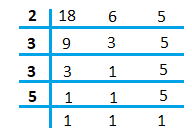
LCM = 2 × 3 × 3 × 5 = 90 Least number = 90 Least number leaving remainder 5 = 90 + 5 = 95 Thus, 95 is the least number which when divided by 6, 15 and 18 leave remainder 5 in each case. 9. Find the smallest 4-digit number which is divisible by 18, 24 and 32. Solution: The smallest 4 digit number is 1000. LCM (18, 24, 32) 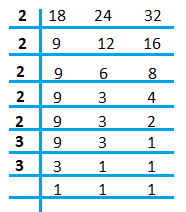
LCM = 2 × 2 × 2 × 2 × 2 × 3 × 3 LCM = 288 The nearest multiple of 288 to 1000 is 288 × 4 = 1152 Thus, the smallest 4-digit number which is divisible by 18, 24 and 32 is 1152. 10. Find the LCM of the following numbers : (a) 9 and 4 Solution: 36 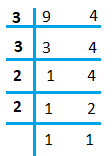
LCM = 3 × 3 × 2 × 2 = 9 × 4 = 36 (b) 12 and 5 Solution: 60 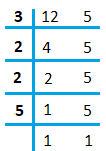
LCM = 3 × 2 × 2 × 5 = 60 (c) 6 and 5 Solution: 30 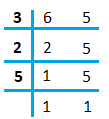
LCM = 3 × 2 × 5 = 30 (d) 15 and 4 Solution: 60 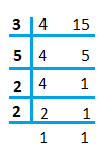
LCM = 3 × 5 × 2 × 2 = 60 Observe a common property in the obtained LCMs. Is LCM the product of two numbers in each case? Answer: Yes, if the two numbers are co-prime numbers. The above two numbers are co-prime numbers, i.e., has only 1 as the common factor. LCM of such numbers is their product. 11. Find the LCM of the following numbers in which one number is the factor of the other. (a) 5, 20 Answer: 20 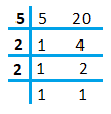
LCM = 5 × 2 × 2 LCM = 20 (b) 6, 18 Answer: 18 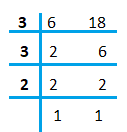
LCM = 2 × 3 × 3 LCM = 18 (c) 12, 48 Answer: 48 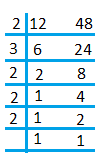
LCM = 2 × 3 × 2 × 2 × 2 LCM = 48 (d) 9, 45 Answer: 45 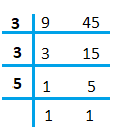
LCM = 3 × 3 × 5 LCM = 45 What do you observe in the results obtained? Solution: We observed that the LCM of the above two numbers is the greater number. It means that if one number is a factor of the other, the LCM will be the greatest number.
Next TopicClass 6 Maths Chapter 4
|
 For Videos Join Our Youtube Channel: Join Now
For Videos Join Our Youtube Channel: Join Now
Feedback
- Send your Feedback to [email protected]
Help Others, Please Share









